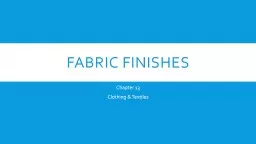

Chapter 13 Clothing amp Textiles Finishing processes Finishes any special treatments applied to improve a fabrics appearance texture or performance Color and design finishes Gray goods ID: 271945
Download Presentation The PPT/PDF document "Fabric Finishes" is the property of its rightful owner. Permission is granted to download and print the materials on this web site for personal, non-commercial use only, and to display it on your personal computer provided you do not modify the materials and that you retain all copyright notices contained in the materials. By downloading content from our website, you accept the terms of this agreement.
Slide1
Fabric Finishes
Chapter 13
Clothing & TextilesSlide2
Finishing processes
Finishes
any special treatments applied to improve a fabric’s appearance, texture, or performanceSlide3
Color and design finishes
Gray goods
when fabric first comes from the loom (no color)Slide4
Dyeing textiles
Dyes
compounds that penetrate and color fibers
Natural dyes
Used for centuries
Obtained from plants, insects, shellfish, and minerals
First synthetic dye was discovered by accident in 1856Slide5
Five different methods used for dyeing
Stock dyeing
natural fibers are dyed before they are spun into yarns
Solution dyeing used when manufactured fibers are produced, dye is added to the liquid solution that goes through the spinneret
Yarn dyeing yarns are dyed before weaving or knitting
Piece dyeing fabric is dyed after weaving or knitting
Garment dyeing the fabric is cut and sewn into the finished product and then the entire garment is dyedSlide6
Colorfastness
Fabric that doesn’t fade, whether its been washed or exposed to chlorine or sunlightSlide7
Printing textiles
Color is transferred to the surface of a fabric to form a pattern
Four most common printing methods
Screen
Rotary screen
Roller
Heat transfer
Other methods that you can try yourself are…
Tie-dyeing
PaintingSlide8
Printing Textiles
Screen
printing
See how Screen Printing is done at https://
www.youtube.com/watch?v=VbzKLUl48Yk
Slide9
Printing textiles
Roller
printing
See how it’s done at https://
www.youtube.com/watch?v=m8W2g-YvjPw
Slide10
Printing textiles
Rotary screen
printing
See how it’s done at
https
://
www.youtube.com/watch?v=R04Dbm3ZRAE
Slide11
Printing textiles
Heat-transfer
printing
See how its done at https://
www.youtube.com/watch?v=t4byFS15S8s
Slide12
Texture finishes
Calendaring
fabric passes between two heated rollers that smooth the fabric and improve the lusterSlide13
Texture finishes
Glazing resin applied during calendaring to produce a high polish or
glaze
on the surface
Embossing fabric is given a raised design on the surface
Embossing fabric example below…Slide14
Texture finishes
Cire (
suh
-RAY) a super-glossy finish is obtained by applying wax or some other substance before
calendaringSlide15
Texture finishes
Moiré (Mwah-RAY) a watered or wavy pattern is obtained by calendaring two layers of fabric slightly off grainSlide16
Texture finishes
Napping rotating wire brushes raise the short fiber ends of staple yarns to create a soft and fuzzy surface called the napSlide17
Textile finishes
Stone washing and acid washing pumice stones are added to a mass-production laundering processSlide18
Textile finishes
Mercerization gives cotton added luster, strength, and
drape ability.
It also improves fabrics affinity for dye. Fabrics and yarns are treated with a caustic soda or lye solutionSlide19
Textile finishes
Sizing starches or resins are added to the fabric for extra body, usually only a temporary finishSlide20
Performance finishes
Antibacterial or antiseptic
checks the growth of bacteria and fungi, such as mold and mildew
Antistatic by absorbing small amounts of moisture from the air, this finish reduces the fabric dryness that causes static electricity
Crease-resistant Applied to fabrics that wrinkle easily (cotton, rayon, linen)
Durable press garments maintain a pressed appearance despite repeated washings and wearings
Flame-resistant and flame-retardant reduce flaming or burning of fabrics exposed to a flame or high heatSlide21
Performance finishes
Mothproof repels moths and other fiber eating insects
Shrinkage control MINIMIZES shrinking
Soil release dirt and stains release more easily from the fabric
Water- and stain-repellent yarns are coated with a chemical that repels water and other liquids
Waterproof fabrics have been coated or treated so that no water penetrates